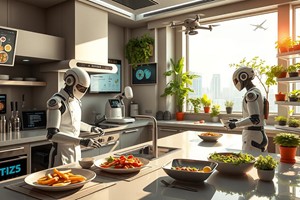In recent years, air fryers have surged in popularity, reflecting a shift in consumer behavior towards healthier, more convenient cooking methods. This rise is creating a new consumption space in the food market, prompting companies to adapt and innovate in response to the growing demand. FoodBev’s Rafaela Sousa explores how air fryers are reshaping culinary habits and influencing consumer choices.
The Emergence and Evolution of Air Fryers
Air fryers made their market debut in the early 2010s, introduced by companies such as Philips. Initially marketed as a healthier alternative to traditional deep frying, air fryers were designed to mimic the results of deep frying using significantly less oil. They leverage rapid air technology to cook food, based on the principles of convection ovens. By circulating hot air around the food at high speed, air fryers cook food evenly, resulting in a crispy finish.
Economic and Health Benefits
In addition to their health benefits, air fryers offer an economic advantage. They save on cooking oil costs over time and contribute to lowering overall food expenditures by enabling families to prepare meals at home more affordably. This is particularly significant as the cost of living rises, making it imperative for households to find cost-effective ways to maintain healthy eating habits without sacrificing quality or taste.
Market Growth and Consumer Adoption
According to market research firm Statista, the revenue in the UK air fryers market amounts to €142.9 million in 2024, with an expected annual growth rate of 10.62% from 2024 to 2029. Manufacturers have responded robustly to this trend, offering a wide range of air fryer models that cater to diverse needs and budgets. From compact units for small kitchens to advanced models with multiple cooking functions, a plethora of options are now available.
Innovative Models and Features
For instance, Philips has continued to innovate with its latest model, the Philips Airfryer 3000 Series Dual Basket, launched in April. This unit allows users to time two dishes simultaneously, ensuring they are ‘crisp, tender, and evenly cooked’ using its RapidAir Technology. Ninja, a UK-based company known for its kitchen appliances, recently introduced the Ninja Double Stack XL air fryer. This model features a narrower but taller design compared to typical air fryers and grills, occupying 30% less space yet boasting a 9.5-liter capacity that can accommodate up to eight people.
Meanwhile, Gourmia announced the launch of an all-in-one air fryer, grill, panini maker, and multicooker. Versia, with its 14 one-touch cooking functions, was designed to revolutionize meal preparation for busy cooks.
Impact on the Food and Beverage Market
The growing popularity of air fryers is carving out a new consumption space within the food and beverage market. Cookbooks and magazines dedicated to air frying are becoming common, with entire publications focused on air fryer recipes, tips, and trends. The trend has even expanded to the entertainment industry with a new TV series dedicated to air fryers. English celebrity chef Jamie Oliver, in collaboration with French cookware manufacturer Tefal, has launched a show called Jamie’s Air-Fryer Meals, demonstrating easy and effective ways to maximize the use of this appliance.
Innovations and Product Development
This year has seen the introduction of several new ranges from popular food brands, specially designed to align with this trend. Many are now offering pre-packaged, air-fryer-friendly foods, including frozen items that are pre-seasoned and portioned for optimal air frying results.
Swiss food and beverage giant Nestlé has developed a range of products specifically for the air fryer. Available in three varieties – double cheddar steak, grilled chicken parmesan, and cheddar bacon tomato – Nestlé's Stouffer’s brand has released the Melt-Fulls frozen sandwiches, made with real cheese and Italian bread.
In April, McCain Foods partnered with Ninja to launch a new product line tailored for air fryers, debuting with two initial offerings. The lineup features McCain’s popular items, including Deep Ridge Crinkle Fries and French Fries, promising cooking times of under eight minutes for ‘maximum crispiness.’ UK-based food brand MJ’s Diner has also unveiled a new range of frozen ready meals tailored for air fryers. The lineup includes 14 meal options designed to provide a convenient 'fakeaway' experience, including salt and pepper chicken, katsu chicken curry, kebab, steak pie, and sausages, and chips and gravy, all of which cook in less than 20 minutes.
Social Media Influence
Companies are also investing in social media platforms to promote their products. Platforms such as Instagram, TikTok, and Pinterest have fueled the surge in air fryer popularity. Users share innovative recipes, cooking tips, and photos of air-fried dishes, inspiring others to try new creations. For example, TikTok creators often showcase their air fryer recipes, turning ordinary meals into visually appealing and appetizing content. Hashtags like #AirFryerRecipes and #AirFryerMeals have garnered thousands of views, featuring a variety of innovative dishes, with air fryer fans sharing recipes for salmon fillets with a crisp exterior, mozzarella sticks with gooey cheese, air-fried doughnut bites, crispy tofu cubes, and many more.
Culinary Innovations
Some of the craziest air fryer recipes have been pushing culinary boundaries. For instance, air-fried sushi rolls combine the freshness of sushi with a crunchy exterior, while air-fried hard-boiled eggs bring together the familiar tenderness of a boiled egg with a surprisingly crispy coating.
The rise of air fryers has demonstrated a significant change in consumer preferences towards healthier and more convenient cooking methods. As companies continue to innovate and cater to this growing market, air fryers are likely to become an integral part of the modern kitchen. This ongoing trend signifies not only a technological advancement but also a broader shift towards sustainable and health-conscious living.














